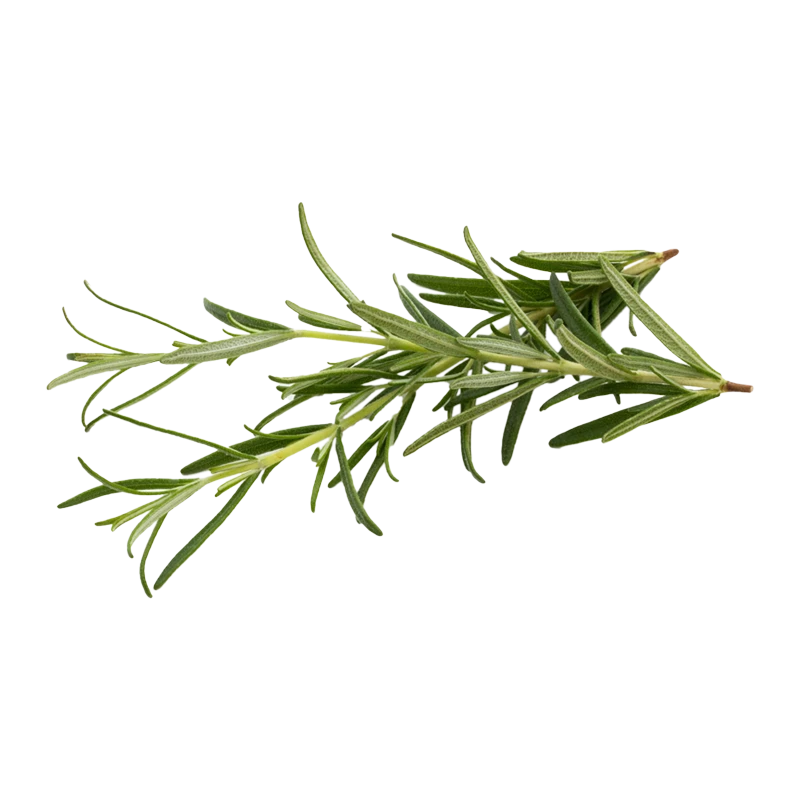Rosemary — Nutrients, Health Benefits, and Shopping Tips

Written by Listonic Team
Last update on September 6, 2024
Rosemary nutrients
Nutrition facts
Amount per 100 g
Calories
🔥 131 kcal
| Nutrition per: 100 g | Value | % Daily Value* |
|---|---|---|
| Carbs | 21 g | 7.64% |
| Fiber | 14 g | 50% |
| Sugars | 0 g | - |
| Glycemic Index | 0 | - |
| Protein | 3 g | 6% |
| Sodium | 26 mg | 1.13% |
| Total Fat | 6 g | 7.69% |
*The % of Daily Value (DV) tells you how much a nutrient in a serving of food contributes to a daily diet. 2,000 calories a day is used for general nutrition advice.
14 g
✅ High Fiber Content
Rosemary facts & tips
Health benefits
- Rich in antioxidants such as rosmarinic acid and carnosic acid, which help protect the body from free radicals and reduce inflammation.
- Contains antimicrobial properties, which can help fight off infections and improve overall health.
- Supports digestive health by stimulating the production of digestive enzymes.
- May improve cognitive function and memory due to its antioxidant content.
Health risks
- Potential for allergic reactions in some individuals, particularly those allergic to plants in the Lamiaceae family, causing symptoms like itching, swelling, or difficulty breathing.
- Potential for digestive discomfort such as stomach upset or diarrhea when consumed in large quantities, particularly in sensitive individuals.
- Potential for interactions with medications particularly blood thinners, as rosemary may have mild anticoagulant effects.
- Risk of contamination with pesticides or harmful bacteria if rosemary is not properly washed or sourced from reputable suppliers.
How to choose rosemary
Rosemary should have stiff, needle-like leaves that are deep green in color, with a strong, aromatic scent when rubbed. The stems should be woody but flexible, indicating they are fresh and healthy.
Do not buy rosemary that is limp or has brown, dried-out leaves, as these are signs of old age or dehydration. Rosemary with a mild or absent fragrance should also be avoided, as it will not provide the desired flavor in culinary uses.

How to store rosemary
Fresh rosemary should be stored in the refrigerator, wrapped in a damp paper towel and placed in a plastic bag. Keeping it in the crisper drawer helps maintain its flavor and freshness for up to two weeks.
Exposure to moisture can cause rosemary to mold quickly. Avoid washing it before storage, as excess water can lead to spoilage. Always trim the stems and use within a few days for optimal flavor and aroma.
✅ Extra Tip
How long does it last?
Rosemary can last for 1-2 weeks in the refrigerator when stored in a plastic bag with a paper towel to absorb excess moisture. For longer storage, rosemary can be dried and kept for up to 6 months in an airtight container.
What to do with leftovers?
Leftover rosemary can be used in a variety of culinary and non-culinary ways. In the kitchen, rosemary adds a fragrant, pine-like flavor to dishes like roasts, stews, breads, and marinades. It’s often used to season meats like lamb, chicken, and pork, as well as roasted vegetables and potatoes.
Beyond cooking, rosemary has several practical uses. It can be used in homemade beauty treatments, such as mixing it with olive oil to create a nourishing hair treatment that helps add shine and promote hair growth. Rosemary can also be used in DIY cleaning solutions due to its natural antibacterial properties; steeping it in vinegar makes a great all-purpose cleaner. Additionally, rosemary can be used in homemade potpourri or sachets to add a refreshing, herbal scent to your home. Some people also use rosemary in natural remedies, such as making rosemary tea to help improve digestion or relieve headaches.
👨⚕️️ Medical disclaimer
Discover products from other categories
Listonic Team
Fact-checked
Our editorial team checked this article to make sure it was accurate at the time of publishing it.
Get the top-rated shopping list app on your phone!







